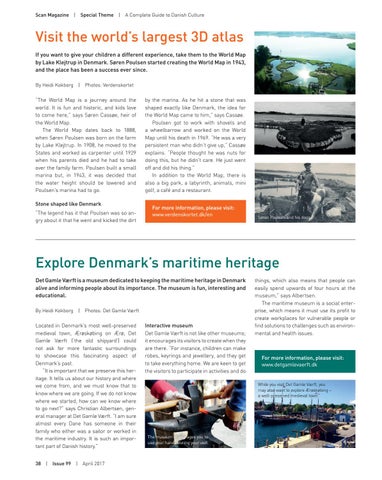Scan Magazine | Special Theme | A Complete Guide to Danish Culture
Visit the world’s largest 3D atlas If you want to give your children a different experience, take them to the World Map by Lake Klejtrup in Denmark. Søren Poulsen started creating the World Map in 1943, and the place has been a success ever since. By Heidi Kokborg | Photos: Verdenskortet
“The World Map is a journey around the world. It is fun and historic, and kids love to come here,” says Søren Cassøe, heir of the World Map. The World Map dates back to 1888, when Søren Poulsen was born on the farm by Lake Klejtrup. In 1908, he moved to the States and worked as carpenter until 1929 when his parents died and he had to take over the family farm. Poulsen built a small marina but, in 1943, it was decided that the water height should be lowered and Poulsen’s marina had to go. Stone shaped like Denmark “The legend has it that Poulsen was so angry about it that he went and kicked the dirt
by the marina. As he hit a stone that was shaped exactly like Denmark, the idea for the World Map came to him,” says Cassøe. Poulsen got to work with shovels and a wheelbarrow and worked on the World Map until his death in 1969. “He was a very persistent man who didn’t give up,” Cassøe explains. “People thought he was nuts for doing this, but he didn’t care. He just went off and did his thing.” In addition to the World Map, there is also a big park, a labyrinth, animals, mini golf, a café and a restaurant. For more information, please visit: www.verdenskortet.dk/en
Søren Poulsen and his dogs.
Explore Denmark’s maritime heritage Det Gamle Værft is a museum dedicated to keeping the maritime heritage in Denmark alive and informing people about its importance. The museum is fun, interesting and educational. By Heidi Kokborg | Photos: Det Gamle Værft
Located in Denmark’s most well-preserved medieval town, Ærøskøbing on Ærø, Det Gamle Værft (‘the old shipyard’) could not ask for more fantastic surroundings to showcase this fascinating aspect of Denmark’s past. “It is important that we preserve this heritage. It tells us about our history and where we come from, and we must know that to know where we are going. If we do not know where we started, how can we know where to go next?” says Christian Albertsen, general manager at Det Gamle Værft. “I am sure almost every Dane has someone in their family who either was a sailor or worked in the maritime industry. It is such an important part of Danish history.” 38 | Issue 99 | April 2017
Interactive museum Det Gamle Værft is not like other museums; it encourages its visitors to create when they are there. “For instance, children can make robes, keyrings and jewellery, and they get to take everything home. We are keen to get the visitors to participate in activities and do
things, which also means that people can easily spend upwards of four hours at the museum,” says Albertsen. The maritime museum is a social enterprise, which means it must use its profit to create workplaces for vulnerable people or find solutions to challenges such as environmental and health issues.
For more information, please visit: www.detgamlevaerft.dk
While you visit Det Gamle Værft, you may also want to explore Ærøskøbing – a well-preserved medieval town.
The museum encourages you to use your hands during your visit.
